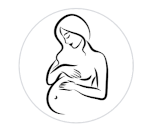
Should you have your baby given a bath upon his arrival?
Or should you let him covered with the fluids of the mother’s womb?
Learn about vernix caseosa, a protective layer naturally created by the mother and its protective role for the baby.
In the delivery room, a bath is given to the newborn child to wash him from the delivery germs but also to put him in a familiar liquid environment, just as in his mom’s womb. It also allows the father to participate and to have a first contact with his baby.
However, it has been shown that a baby is born with a protective layer called vernix caseosa: the more the baby is premature, the more he has vernix caseosa on his body, and the more the baby is overdue, the less he will have this layer at birth.
What is vernix caseosa?
It is a coating that protects and hydrates the baby’s skin and that is so efficient that scientists try to reproduce it to heal the burns unit.
When a bath is given to the newborn child in the delivery room, this layer is removed from his skin. This action exposes it to risks of dryness, dehydration and micro-lesions.It is important to know that during his first month, the newborn’s skin is immature and needs maximum protection. It is therefore necessary to limit the number of baths given during the baby’s first month of life.
WHO acknowledges that newborn babies must not be given a bath. Yet, they make an exception for religious practices but still recommend waiting at least 6 hours before bathing the baby because it will endanger his skin and also because he might get cold. If the baby is cold, he will consume energy that will cause a drop in his blood sugar levels. He will then have difficulty sleeping and won’t eat properly.
Giving a bath to the baby in the delivery room is therefore not recommended.
It is also advisable to limit the number of baths during the first month.
